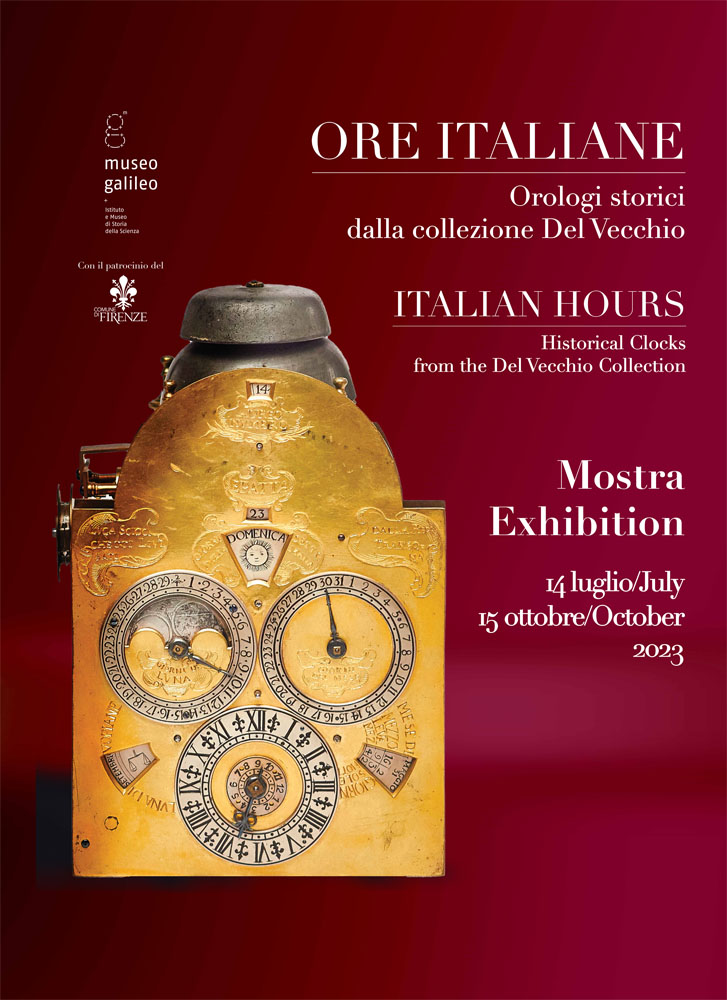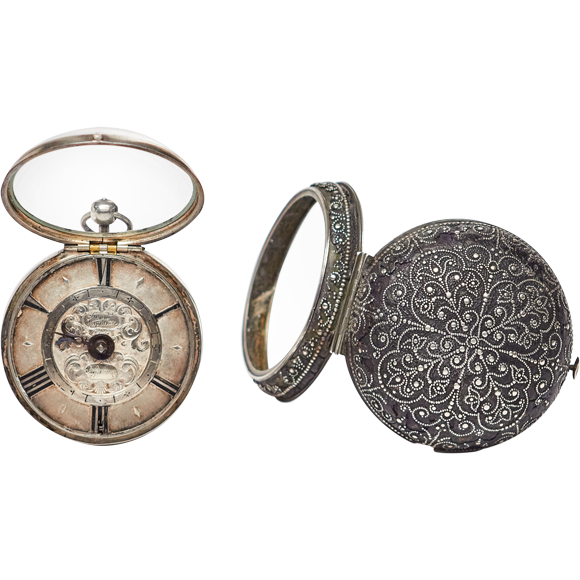Museo Galileo
Entrance fees to the Museum include the access to the Exhibition
Italian Hours
Collectors always played a critical role in creating museum collections. The exhibition Italian Hours—curated by Antonio Lenner and Giorgio Strano—emphasizes this often undervalued fact by showing a choice of Italian clocks which were found, kept, and studied by Gian Carlo Del Vecchio (1918-2016). In sixty years’ unceasing work, this great collector created a specialized gathering that is in no way inferior to those of major museums in the world.


The sixty masterpieces on display, datable from the fifteenth to the beginning of the nineteenth century, are a very significant nucleus of the whole collection, which comprises more than three hundred clocks. In order to make the evolution of time-measuring systems in Italy better understandable, the exhibition also includes some instruments for measuring time which were conceived before the spreading of mechanical clocks. A choice of tools used by master clockmakers to create their artworks are also on show.

COLLECTIBLE MASTERPIECES
The historical clocks on display—table, wall, and tower clocks—are not only beautiful and illustrative of the work of some of most renowned Italian clockmakers. On the one hand, they bear witness to the human obsession for measuring and controlling time, in the vain attempt to dominate it, as sometimes portrayed on clock cases and dials. On the other hand, some of the clocks on display tell stories of their own, which are satellite to the general history of technological progress. The night clocks made by the Campani brothers are a good example of these particular stories. They were conceived in baroque Rome to fulfill the Pope’s desire of knowing what time it was without lighting a candle and, above all, without the maddening ticking that disturb sleeping.
Highlights
Table clock
Antonio Torri (18th-19th century)
1812
Gilded bronze, iron, enamel; 16 x 10 x 25 cm
Milano, Private collection
On the clock base of this clock are three cartouches: the central one contains a large N (for Napoleon); the lateral cartouches display a G and an L, the initials of the clock’s first owner, Giuseppe Luosi. Count Luosi of Mirandola (1755-1830) was Minister of Grace and Justice in the Kingdom of Italy and enjoyed special consideration from Napoleon, who privileged him with the Legion of Honor.
Pocket watch
Francesco Papillon (17th-18th century)
ca. 1690
Silver, brass, fish skin; diameter ca. 8 cm
Milano, Private collection
The special characteristic of this pocket watch is the outer case, which is covered in fish skin and decorated with silver studs.
Astronomical table clock
Domenico Mezzanotte (1731-1797)
mid-18th century
Ebonized wood, copper, brass, glass; 40 x 20 x 55 cm
Milano, Private collection
The eleven dials of this astronomical clock have several functions: they indicate the Sun’s position, the duration of month, the age and phase of the Moon, and Zodiac sign. They also give other indications—some of them still unexplained today—probably for astrological use. The back opening allows access to the complex mechanism. Domenico Mezzanotte was a skilled clockmaker who also built belfry clocks for the churches of the Valsugana area (east of Trento).
Night clock
Giuseppe Campani (1635-1715)
Rome, ca. 1660
Ebonized wood, gilded metal, copper; 53 x 34 x 13 cm
Milano, Private collection
The dial represents an old man watching four young girls (the Seasons) who, performing a round dance, recall the circularity of time. The old man points to the semicircular opening in which Chronos pushes the circle with the numeral indicating the hour. The inventory of items at Palazzo Pitti, in Florence, at the death of Prince Ferdinand I de’ Medici in 1713, describes a clock “made of ebony, 18 soldi [ca. 54 cm] high at its tallest point, with a painted copper face showing four nymphs dancing and a seated old man pointing, for them, to the passing of time, which is painted in the band showing the hour; [the clock] serves for the night, with modillions and a niche above the black-tinted pear-wood cornice”. The description suggests that this night clock by Giuseppe Campani might be the item recorded in the inventory.
Pendulum table clock
ca. 1670
Wood, semi-precious stones, parchment, gold leaf; 47 x 22 x 75 cm
Milano, Private collection
A gorgeous example of the refinement of many pendulum table clocks, items having both practical and ornamental functions. The case is made with inlays of various woods and semi-precious stones, and is adorned with gold-leaf notched moldings. The small drawer at the bottom, also decorated with semi-precious stone inlays, contains the winding key.
Night clock
Pietro Tommaso Campani (active 1656-1682)
1670
Ebonized wood, bronze, copper, iron, brass; 80 x 36 x 120 cm
Milano, Private collection
This is one of the night clocks made by the Campani brothers—Matteo (1620-1678), Pietro Tommaso (active 1656-1682) and Giuseppe (1635-1715)—for Pope Alexander VII. The Pontiff, who suffered from insomnia, asked his majordomo, Cardinal Gerolamo Farnese, “a clock for the night, displaying the hours clearly and distinctly, but in such a manner that the light from the lamp or lantern does not disturb the eyes of the viewer [...], and makes no noise to mark the time”. After various attempts, the Campanis built a clock that met those requirements. Alexander VII, satisfied with the result, granted an invention patent forbidding anyone else in the Papal State to build or sell similar clocks. The painting on the face shows a rural scene where an old man draws the attention of a young woman to the allegorical figure of Time holding a scythe and flying over them.

 EN
EN  IT
IT 






